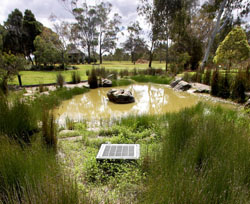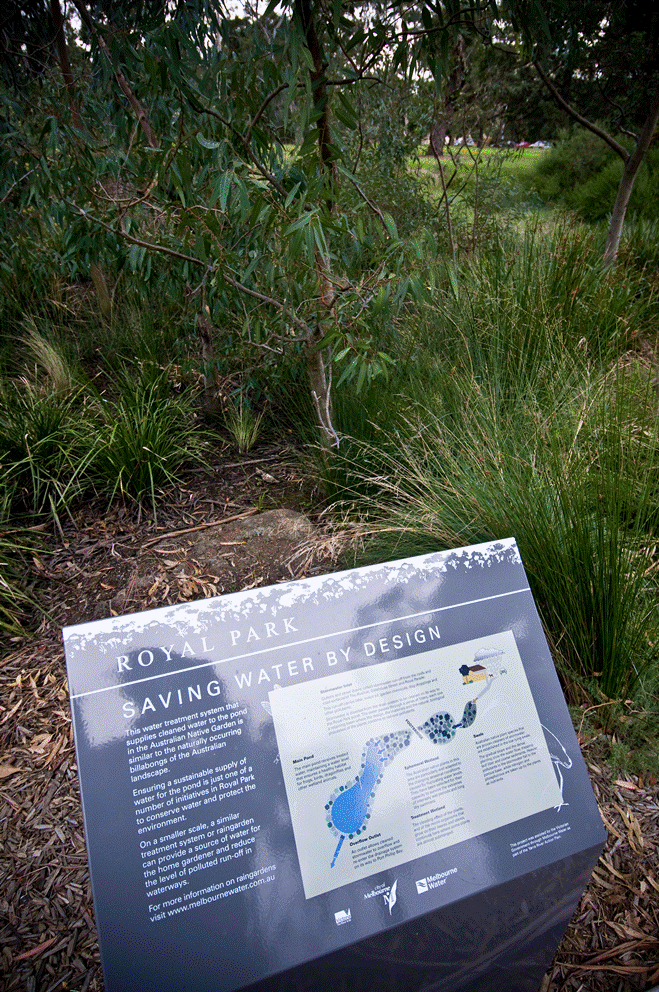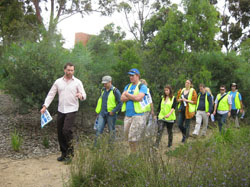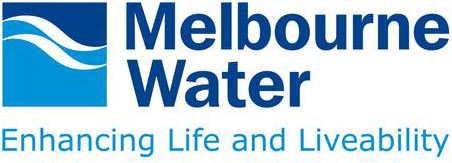resource library
Array
Royal Park wetland

Signs provide park visitors with information about the system

The stormwater harvesting system at Royal Park is a common destination for industry tours
Royal Park Stormwater Harvesting Project
City of Melbourne
Corner Galada Ave and Oak Street, Parkville, Victoria | Map:
Published: 04 March 2013
Project Overview
The Royal Park stormwater harvesting project is one of Melbourne's most successful and well established stormwater harvesting projects. Located just 4km from Melbourne's CBD, Royal Park spans over 170 hectares of green open space, typically used for recreational activities such as team sports, walking, running, and cycling. The park is also home to a number of sporting clubs and facilities, and the Royal Melbourne Zoo.
The 1984 Royal Park Master Plan proposed the development of a wetland, which would provide a range of benefits to the local community. In 1998, following on from this preliminary idea, a stormwater harvesting system was included in the Master Plan, and the conceptual design was finalised in 2004. When Melbourne hosted the Commonwealth Games in 2006, there was a strong push for environmental initiatives. Given that the chosen site for the Athlete's Village was adjacent to the proposed wetland location, the construction of the Village became the main driver to implement the wetland and stormwater harvesting project. It was completed in time for the 2006 Commonwealth Games and the area was included in the secure recreation zone of the Athlete's Village.
Stormwater is diverted from an open Melbourne Water stormwater drain, which collects water from a 187ha catchment area. The diversion structure, which also acts as a sediment trap, allows only low flows into the constructed wetland which is 0.8ha in size. The treated water then flows into a 12ML storage basin, which allows overflow into Moonee Ponds Creek. This storage space was supplemented in 2008 by a 5ML underground tank, situated below one of the sporting fields. To ensure the water is fit-for-purpose, it is treated with UV light and held in a distribution tank prior to use for irrigation of the neighbouring golf course, sports oval sand parkland. To minimise human health risks, the water is applied at night-time through spray irrigation. The system has a back-up supply with a connection to potable mains water. Two water hydrants are also located in an adjacent street to allow trucks to fill up and use the treated water for irrigation of streetscape features.
This stormwater harvesting project now forms part of the City of Melbourne's vision of 'City as a Catchment': to create resilient water management solutions which buffer against the effects of drought and population growth, whilst simultaneously reducing the impact of stormwater on receiving waterways and improving the ecological health of the site.
Drivers and Objectives
Due to the duration of this project and the changes in design, the objectives changed over time. Overall objectives included:
- Increased biodiversity
- Enhanced visual amenity
- Provision of additional recreational opportunities
- Reduction of potable water demand by providing an alternative non-potable water source for irrigation
- Protection of downstream ecosystems through:
- Pollutant reduction
- Minimisation of stormwater runoff volumes and frequency - Provision of educational opportunities - visitors and schools
- Management of human health risks associated with the use of treated stormwater
- Management of site challenges such as the presence of contaminated soil and underground services (power, drains etc.)
Organisations
- City of Melbourne (Responsible council and funding partner)
- Melbourne Water - Living Rivers Program (Funding partner)
- Victorian State Government (Funding partner)
Rush Wright and Associates, Ecological Engineering (Design consultant) - Grogan Richards (Civil engineers)
- Akron Roads (Civil construction)
- ten Buuren Irrigation Designs (Irrigation consultant)
- Australian Land Management (Landscape design)
- Australian Ecosystems (Planting implementation)
- Serco Australia (Landscape management)
- Monash University (Monitoring)
In addition, the consultation process for the Planning of the Royal Park wetlands included an extensive list of stakeholders and the community. The Royal Park Master Plan implementation Advisory Committee comprising of Council's parks and recreation staff, stakeholders and community representatives; met bi-monthly with the Melbourne Zoo, EPA, the Office of Commonwealth Games Coordination, and Melbourne Water to discuss key objectives of the Park's Master Plan of 1998.
Project Outcomes
Environmental outcomes:
- Reduced stormwater pollutant loads and runoff volumes entering Port Phillip Bay. A monitoring campaign revealed that the system was performing above modelled expectations for nutrient and sediment removal (MUSIC modelling).
- Reduced potable water demand for Council: 80% of the total irrigation demand (119 ML/year) can be supplied by the stormwater harvesting scheme.
- New wetland habitat for birds and frogs.
Economic outcomes:
Provides economic benefit to both the community and council by replacing potable water initially used for irrigating the site, with low cost recycled water (less than $2.00/kL).
The project design minimises operational and maintenance costs:
- The entire treatment system is gravity fed until it reaches the storage basin, where water is pumped out for disinfection and distribution.
- The irrigation control system minimises the use of pumps through optimal patterns and levels of watering.
- To minimise the cost of waste disposal, sediment taken out of the sediment basin during clean-up operations is dried and kept on site (out of public view).
A carbon emission analysis indicated that, although the Royal Park project produces more greenhouse gas emissions than reticulated water, it produces less than equivalent larger scale alternative water schemes such as sewer mining and desalination.
Social and human health outcomes:
The wetland and the irrigated areas (golf course, sports ovals and passive recreational spaces) contribute to the enhanced amenity of Royal Park.
Extensive community involvement and education was achieved through this project:
- Extensive community consultation enabled people to contribute to the design of the project.
- The traditional owners of the land were recognised through a consultation process with the Wurundjeri Council, which gave the wetland the name 'Trin Warren Tam-boore' (bellbird waterhole).
- Council-sponsored community planting days contributed to the sense of ownership and appreciation of the wetlands.
- Large numbers of school groups visit the site for guided tours by council staff to learn about the fauna, flora, water treatment and cultural elements of the area.
- Signage throughout the wetland precinct educates visitors about the wetland processes and its integration with the local ecosystem.
Parklands and sporting ovals can remain green all year round through regular irrigation and thereby contribute to community wellbeing.
Park trees irrigated with harvested stormwater contribute to a reduction in the urban heat island effect: they provide shade, increase local evapotranspiration processes, and therefore decrease local temperatures.
The following initiatives were taken to minimise human health risks and comply with the Victorian Stormwater Harvesting Guidelines:
- A 'treatment train' approach ensures efficient pollutant removal (sediment trap, wetland, storage, UV).
- Night-time spray irrigation minimises exposure to treated stormwater.
- Educational signage explaining the treatment process that has been installed on site.
- Targeted education for all users of the system (such as irrigation managers).
- Irrigation managers were involved in developing the recycled water management plan.
Lessons Learnt
Modelling suggested that more water could be harvested, however there were significant challenges to overcome: space constraints for additional storage and a restricted diversion licence. A feasibility study showed that additional underground storage could be located below one of the sporting fields, and discussions with Melbourne Water resulted in a new diversion licence.
While expensive, monitoring can allow early detection of potential problems. The monitoring campaign undertaken at Royal Park revealed that some parameters (such as iron, salinity and turbidity) measured up slightly above guideline values. These parameters will be monitored regularly in the long term to prevent any issues arising.
Success of this project was ensured by the enduring commitment of the City of Melbourne and Melbourne Water, as well as consistency with the use of the same design consultants (from preliminary studies to final sign-off). The same design consultants were called upon for the design of the system upgrades in 2008.
The duration of the project was extended due to the complexity of operating in a high profile and highly political landscape. Despite the multiple challenges, it provided the opportunity to improve the design, building on industry and community knowledge.
Collaboration between stakeholders helped changed the views of those initially sceptical with some later becoming ambassadors for the project.
A recent risk assessment helped clarify responsibilities between Melbourne Water, City of Melbourne and the respective contractors. The risk assessment report provides guidance on how and when communication between the agencies needs to occur, especially during abnormal operational conditions
Project Cost
The total cost of this project was $8,020,000 with the following breakdown:
- 2006: Wetland construction: $5,000,000
- 2006: Reticulated irrigation: $200,000
- 2008 upgrade: Underground storage construction: $2,000,000
- 2008 upgrade: Upgrade to pumping infrastructure: $320,000
- 2008 upgrade: Extension of reticulated irrigation system: $500,000
Timeframe
1984 - Development of Royal Park Master Plan
1998 - Stormwater harvesting system included in new Master Plan
2002 - Preliminary feasibility study for stormwater harvesting system
2004 - Concept design completed for the stormwater harvesting system
2006 - Completion of project (in time for the Melbourne Commonwealth Games)
2008 to 2010 - System upgrade: installation of additional underground storage tank, increase of diversion licence and upgrade of reticulated irrigation system
Contact
Ralf Pfleiderer, City of Melbourne
T 03 9658 8663
